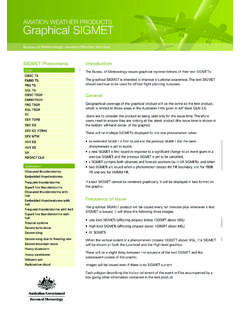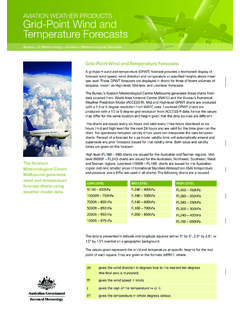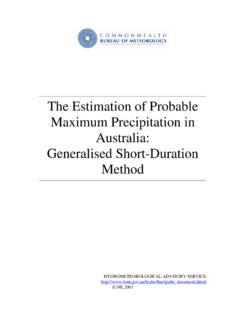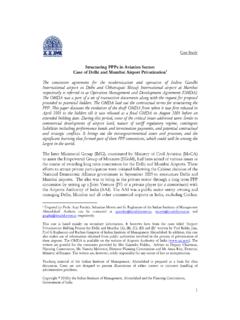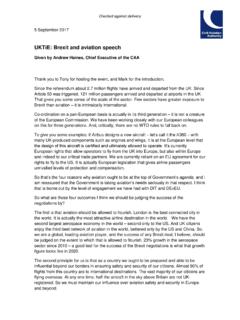Transcription of AVIATION WEATHER PRODUCTS Aerodrome …
1 Explanation of TAF ElementsIdentifier TAF Aerodrome Forecast TAF AMD Amended Aerodrome Forecast TAF COR Corrected Aerodrome Forecast TAF .. CNL Cancelled Aerodrome Forecast TAF .. NIL Aerodrome Forecast will not be issued AVIATION WEATHER PRODUCTSA erodrome Forecast (TAF)Bureau of Meteorology AVIATION Meteorological ServicesA TAF is a coded statement of meteorological conditions expected at an Aerodrome and within a radius of five nautical miles of the Aerodrome reference format of an Australian TAF is as follows:TAF AMD YMML 292330Z 3000/3106 14008KT 9999 SCT030FM301100 14003KT 3000 HZ BKN009 PROB40 3017/3023 0400 FGRMKT 14 15 17 14 Q 1016 1014 1013 1014only used for TSnot used for fogIndicates elements which may or may not be inluded in lineCAVOKVISL ocationValidityValidityCNLWindNILTAF orTAF AMD orTAF COR Issue TimeFM orBECMGTimeWind WindTSStartTimeFinishTimeStartTimeFinish TimeCLDFog, Mist, Dust, Smoke or TURB orMOD/SEV TURB or SEV TURBTEMP The following lines will only be included as requiredsignificant changesto mean conditionssignificant variations from mean conditionsprobabilityof TS or poorvisibilitysignificant low levelturbulenceVISWXCLDCAVOKCLDPROB%(30 or 40%)PROB%(30 or 40%)
2 INTER orTEMPOWXVISVISWXL ocationThe location is given by either an ICAO location indicator or an approved Airservices Australia Time The issue time of the TAF is expressed in a six-figure group followed by the code letter Z, 202230Z gives an issue time of 2230 on the 20th day of the month The period of validity is given in the format ddhh/ddhh, where dd is day of the month and hh is hour UTC, 2100/2206, which gives a 30 hour validity period from 0000 on the 21st to 0600 on the 22nd UTC. Note that 00 is used to indicate periods of validity beginning at 0000 UTC; and 24 is used to indicate periods of validity ending at 2400 wind direction is given in degrees True, rounded to the nearest 10 degrees. A variable wind direction is given as VRB (used when the forecasting of a mean wind direction is not possible).The wind speed is given in knots (KT).
3 The maximum wind gust is included, after the letter G, if it is expected to exceed the mean by 10 knots or more, 28020G30KT gives a wind direction of 280 True, with a mean speed of 20 knots, and a maximum gust of 30 The horizontal visibility is given in metres in increments of 50 metres when visibility is forecast to be less than 800 metres; in increments of 100 metres when forecast to be 800 metres or more but less than 5,000 metres; and in increments of 1,000 metres when forecast to be 5,000 or more but less than 10,000 metres. Visibility is always given in a four figure group: 500 metres is given as 0500. Forecast visibilities of 10 kilometres or more are given as 9999. Visibility is not given when CAVOK is WEATHER is expressed using the abbreviations in the tables on the left. If nil significant WEATHER is expected, and CAVOK is not appropriate, then the group is not included (however NSW - nil significant WEATHER - may be used after a change group [FM or BECMG]).
4 Intensity is indicated for precipitation, duststorms, sandstorms and funnel clouds (tornadoes and water spouts). In these cases, the WEATHER group is prefixed by - for light and + for heavy; moderate intensity has no prefix, +TSRA means thunderstorm with heavy rain; DZ means moderate drizzle; -RA means light Cloud information is restricted to cloud with a base below 5000 feet or the highest 25 nautical mile minimum sector altitude, whichever is greater, and cumulonimbus (CB) and towering cumulus (TCU) at any height. It is given from the lowest to the highest layers in accordance with the following rules: 1st group: the lowest layer regardless of amount 2nd group: the next layer covering more than 2 oktas 3rd group: the next higher layer covering more than 4 oktas Extra group for cumulonimbus when forecast but not at any of the layer heights given above.
5 Cloud amount is given using the following abbreviations in the table on the left. Cloud height is given as a three-figure group in hundreds of feet above the Aerodrome , cloud at 700 feet above the Aerodrome is shown as type is identified only for CB and TCU, DescriptorBCPatchesBLBlowingDRDriftingFZ FreezingMIShallowPRPartialSHShowersTSThu nderstormVCIn the vicinityCodeCloud AmountFEWFew (1 to 2 oktas) SCTS cattered (3 to 4 oktas) BKNB roken (5 to 7 oktas) OVCO vercast (8 oktas) NSCNil significant cloud CodeCloud TypeCBCumulonimbus TCUT owering cumulus PrefixWeather Intensity+Heavyno prefixModerate-LightCodeWeather PhenomenonBRMistDUDustDSDuststormDZDrizz leFCFunnel cloudFGFogFUSmokeGRHailGSSmall hail/snow pelletsHZHazeNSWNil significant WEATHER PLIce PelletsPODust devilRARainSASandSGSnow grainsSNSnowSQSquallSSSandstormVAVolcani c ashUPUnidentified precipitationCAVOKThe abbreviation CAVOK (Cloud And Visibility and WEATHER OK) is used when the following conditions are forecast simultaneously: Visibility is 10 kilometres or more No cloud below 5000 feet or below the highest 25 nautical mile minimum sector altitude whichever is the higher.
6 And no cumulonimbus at any height No WEATHER of significance, none of the WEATHER listed in the WEATHER table Significant Changes and Variations (FM, BECMG, INTER, TEMPO) Significant changes and variations will be included when the changes and variations are expected to satisfy amendment criteria. It should be noted that these changes relate to improvements as well as term FM is used when one set of prevailing WEATHER conditions is expected to rapidly change to a different set of prevailing WEATHER conditions. The indicator is the beginning of a self-contained forecast, with the new conditions applying until the end period of the forecast or until the commencement time of another FM or BECMG term BECMG is used when one set of prevailing WEATHER conditions is expected to change, during the given period, to a different set of prevailing WEATHER conditions.
7 The indicator is the beginning of a self-contained forecast, with the new conditions applying until the end period of the forecast, or until the commencement time of another BECMG or FM any change group (FM or BECMG) there will be information on wind, visibility, WEATHER and cloud; except when CAVOK is given or when fog is forecast. When CAVOK is not given and there is nil significant WEATHER expected, the abbreviation NSW is used. When CAVOK is not given and nil significant cloud is expected, the abbreviation NSC will be terms TEMPO and INTER are used to indicate significant temporary or intermittent variations from the prevailing conditions previously given in the TAF. TEMPO is used for periods of 30 minutes or more but less than 60 minutes. INTER is used for periods less than 30 The term PROB is used in TAF (it is not used in TTF) if the estimated probability of occurrence is 30 or 40% (probabilities of less than 30% are not given), and is only used with reference to thunderstorms or poor visibility (less than the alternate minimum) resulting from fog, mist, dust, smoke or sand.
8 If the estimated probability of occurrence is equal to or greater than 50%, then reference to PROB is not included. When using PROB with thunderstorms, INTER and TEMPO are also included whenever appropriate to indicate the probable duration. Where PROB is used without one of these, the likely period of occurrence will be deemed to be one hour or more. For example:RMKRMK (remarks) precedes information on Turbulence (if forecast), Temperatures and INTER 1205/1211 5000 -TSRA BKN040CB indicates a 30% probability of deteriorations of less than 30 minutes due to thunderstorms with light rain between 0500 and 1100 UTC on the TEMPO 1102/1113 3000 TSRA BKN040CB indicates a 40% probability of deteriorations of 30 minutes or more but less than 60 minutes due to thunderstorms with moderate rain between 0200 and 1300 UTC on the 1005/1014 1000 +TSRA BKN040CB indicates a 30% probability of deteriorations of one hour or more due to thunderstorms with heavy rain between 0500 and 1400 UTC on the reference is made in TAF to hazardous turbulence, other than that associated with CB and TCU, that may endanger aircraft or adversely affect their safe or efficient operation.
9 The TAF contains information on commencement time (FMddhhmm), the expected intensity (moderate [MOD] or severe [SEV]) and the vertical extent ( FT). TILL ddhhmm is used to indicate the cessation of the turbulence when this is expected before the end of the TAF Temperature Air temperature, preceded by the letter T, is given in whole degrees celsius using two figures. If the temperature is below zero, the value is prefixed by the letter M (minus). Forecasts of air temperature are given at three-hourly intervals, for a maximum of nine hours, from the time of commencement of validity of the forecast. They are given for the times HH, HH+3, HH+6 and HH+9, where HH is the time of the commencement of the TAF validity. They are point forecasts for these times, and users should use linear interpolation to determine the forecast value between these QNH, preceded by the letter Q, is given in whole hectopascals using four figures.
10 Forecasts of QNH are given at three-hourly intervals, for a maximum of nine hours, from the time of commencement of validity of the forecast. They are given for the times HH, HH+3, HH+6 and HH+9, where HH is the time of the commencement of the TAF validity. They are point forecasts for these times, and users should use linear interpolation to determine the forecast value between these Examples TAF YMAY 022230Z 0300/0312 35010KT CAVOKFM030800 31018KT 9999 SHRA BKN025 OVC100 INTER 0308/0312 31020G40KT 3000 +TSRA BKN010 SCT040 CBRMK FM030600 MOD TURB BLW 5000 FTT 23 24 28 33 Q 1012 1013 1014 1009 FORECAST DECODE TAF Aerodrome Forecast YMAY Location indicator for Albury Airport 022230Z TAF issued at 2230 on the 2nd day of the month UTC 0300/0312 Validity period of TAF is from 0000 to 1200, on the 3rd day of the month UTC 35010KT Wind will be from the north (350 degrees True) at 10 knots CAVOK Cloud, visibility and WEATHER ok FM030800 Significant changes to the mean conditions are expected to commence from 0800 on the 3rd UTC, and to persist (at least)
